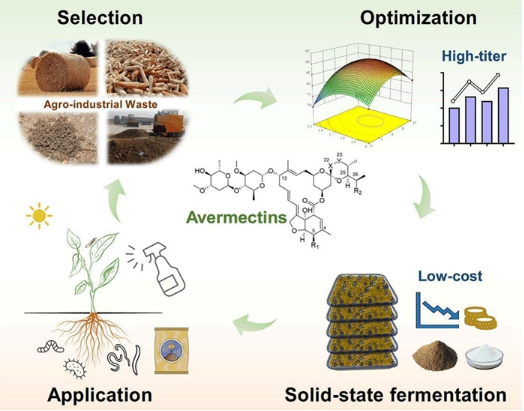A Green Revolution in Biopesticides: Chinese Scientists Turn Waste into Value, Slashing Both Costs and Environmental Footprint for Key Pesticide Production
A landmark scientific breakthrough is quietly reshaping the landscape of the global $3 billion biopesticide market. A research team from the Chinese Academy of Agricultural Sciences (CAAS) has successfully developed an innovative process to produce Avermectin—a biogenic pesticide with the highest global demand, exclusively supplied by China—using solid-state fermentation of agricultural waste. The study, published in the internationally renowned journal Bioresource Technology, not only achieves an 8.38% reduction in cost but also paves a new path for sustainable agriculture.
For a long time, Avermectin production has relied on traditional liquid fermentation technology. While effective, the method has been plagued by the "three highs": high energy consumption, heavy pollution, and prohibitive costs, which has, to some extent, hindered its broader adoption in green agriculture.
To overcome this challenge, scientists from the Institute of Plant Protection at CAAS turned their attention to common agricultural waste, exploring its potential to be upcycled. They systematically screened various agro-industrial byproducts and ultimately identified an optimal "golden formula"—a composition of wheat bran, corncob, sugarcane bagasse, and vermicompost—as the ideal substrate for solid-state fermentation.
The research team didn't stop there. Through precise experimental design and data analysis, they identified the two critical factors influencing fermentation efficiency: substrate moisture content and oxygen supply. Peak Avermectin output was achieved with a substrate moisture content of 78.5% and an inoculation rate of 25%.
More importantly, the technology has demonstrated significant potential for industrial application. The shallow-tray continuous fermentation strategy designed by the researchers enables stable, repeatable production across four consecutive batches, achieving a yield as high as 3.83 mg/g of dry substrate while also significantly shortening the production cycle. Comprehensive calculations show that the new process reduces production costs by 8.38% compared to traditional liquid fermentation.
This innovation also offers an added "dual value": the solid residue remaining after fermentation itself has potential as a microbial pesticide for controlling crop pests and diseases, creating a perfect closed loop for the agricultural circular economy.
The study was led by the Institute of Plant Protection at CAAS, with Ph.D. student Du Guozhong as the first author, and Professor Li Shanshan and Professor Xiang Wensheng of Northeast Agricultural University as co-corresponding authors. This achievement not only provides a new paradigm for the green manufacturing of Avermectin but also offers a replicable blueprint for the development of other natural products derived from Streptomyces, holding profound significance for advancing the green transformation of global agriculture.


